The western Zhou dynasty 1100-770BCE

The founding of the Zhou dynasty is dominated by three revered figures who have epitomize wise and benevolent rule: King Wen, King Wu and the Duke of Zhou. These mythologized rulers provide some of the most epic tales in Chinese history, similar in some ways to King Arthur in the UK. They were frequently referred to by Kongfuzi (Confucius) as exemplary leaders. In the Analects Chapter 3 he writes ‘What a splendid civilization, I am a follower of Zhou’.
As the events date back 3,000 years and were recorded about 1,000 years afterwards it is hard to be sure on the authenticity of the history. It is often the case that a new dynasty makes sure it gives the people who many regarded as usurpers a glowing biography to consolidate their grip on power. The same 'victors writing history' was repeated at the start of the Han, Song and Ming dynasties. The dates are not precise as they were recorded according to the year of an emperor's reign. This then depends on accurate record of each Emperor's reign to form a sequence, there was no absolute base date to number years by. Originally the Zhou dynasty was thought to have began in 1122BCE then moved to 1027BCE but other dates have been suggested.
King Wen 周文王(c. 1112-1050BCE or 1152-1056 BCE)
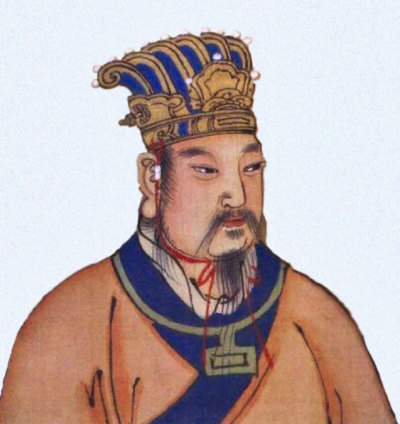
The key figure was neither a King nor called ‘Wen’ as these were honors given to him by his son after his death. He was born as Ji Chang 姬昌; the son of Ji Li 季歷 and grandson of Duke Danfu 公亶父.
Duke Danfu chose Jili as his successor even though he had elder brothers. Although it should be added that this is now thought to have been a widespread tradition of the Zhou people rather than an indicator of deference. The family belonged to the Zhou clan of people living west of the Shang capital along the Wei valley - a major tributary of the Yellow River in modern day Shaanxi. At this time the Shang dynasty ruled over quite a small area mostly in the modern state of Henan to the east.
The area to the west controlled by the Zhou was considered less civilized and perhaps provided victims for human sacrifices carried out by the Shang. Jili, King Wen's father, is said to have been executed by Shang emperor Wen Ding (文丁) . Ji Chang quickly rose to be the key local leader. He married the greatly respected Tai Si ➚. Wen Ding gave him one of his own daughters as a concubine. He appointed wise and competent counselors and was promoted to be one of the Three Dukes under the tyrannical Shang emperor confusedly also called ‘Zhou’ 紂 (more correctly known as 商帝辛 Shāng Dì Xīn.
He was then arrested under a charge of treason made by the Duke of Chong 崇侯 and was imprisoned at Youli 羑里 (modern day 汤阴 in northernmost Henan). As King Wen did indeed plot to overthrow the Shang this does not seem an unreasonable action.
There is a story that his eldest son, Bo Yikao (伯邑考), was falsely incriminated by King Zhou’s concubine Ta Chi and killed. Shang King Zhou then made meat balls out of his son’s flesh and fed them to Ji Chang. Ji Chang was aware of all this by way of divination; however, he could do nothing but eat it to show his submission.
It was during his imprisonment that Ji Chang is credited with inventing the eight trigrams, writing the Yi Jing and putting the 64 hexagrams into order. Archaeological excavation at Qishan has discovered oracle bones inscribed with trigrams so there is clear evidence that the trigram system was in use at this time. After several years of ordeal in prison, Ji Chang finally attained King Zhou’s trust and gained his freedom when the people of Zhou are said to have paid a ransom of a beautiful girl, a fine horse, and four chariots.
After being pardoned he was made ‘Viscount of the West’ Xi Bo 西伯 and resided at Qiyi 岐邑 (modern day Qishan 岐山, near Baoji Shaanxi). In the declining years of the Shang nation squabbling among nobles intensified, Ji Chang acted as a mediator and also held back incursion by Quanrong ➚ raiders from the north-west.
He consolidated his grip on government of the western area and expanded his territory. His skill and wisdom led later writers to view him so similar to the legendary Emperor Shun that they were like ‘two halves of the same seal’. He died before his plans to overthrow the Shang government came to fruition. He died at Cheng 程 and was buried at Bi 畢. It was only after his death that he was given the honorific title 'King' and 'Wen' (meaning cultured).
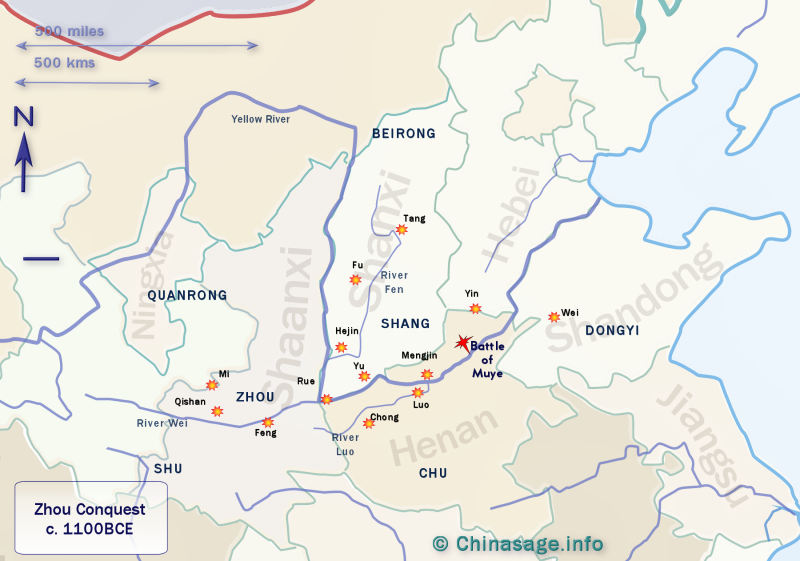
Map of China at the time of the conquest of the Shang capital Yin by King Wu to found the Western Zhou dynasty. Modern provinces shown faintly for reference.
King Wu 周武王 (d. 1043BCE)

Ji Chang's son is really the important one as far as history is concerned as he overthrew the Shang dynasty. He was born as Ji Fa 姬发, King Wen's second son. By this time the tales of cruelty of the last Shang king had spread widely. After an unsuccessful coup attempt, the decisive battle of Muye 牧野 took place in Henan c. 1046BCE. The Shang forces were defeated and the last emperor then set himself and his palace on fire. As is the pattern for a new dynasty the brutality of the take-over is glossed over in the history books, particularly as King Wu is put forward as ‘all virtuous’. The Shang loyalists were hunted down and about 180,000 people were killed with many becoming human sacrifices to the gods.
Ji Fa founded the new dynasty and was proclaimed Zhou Wuwang 周武王. The new center of administration of the Zhou state was in the Wei valley at Hao (鎬) near modern day Xi'an and divided into three divisions Bei, Yong and Wei. He soon bestowed honors on his father as ‘King Wen’ (a very Confucian thing to do).
Like his father the title ‘King Wu’ is an honorific title which means ‘military might’. Together Wen and Wu represent the two instruments of government ‘culture’ and ‘military supremacy’. This is reflected in the ancient maxim: You treat your educated friends and neighbors with culture, while barbarian enemies are tamed with military force.
Duke of Zhou 周文公旦 (d. 1032BCE)
Often known as 周公 Zhōu gōng
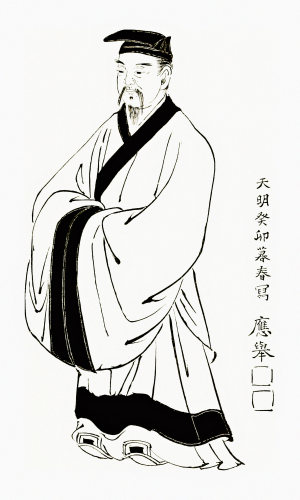
Ji Fa (King Wu) died young, only four years after the founding of the new dynasty. His son Ji Cheng was five years old and so Wu's brother, Jī Dàn姬旦 the Duke of Zhou (r. 1043-1035 BCE) (Wen's fourth son), took control as regent.
This situation led to a crises of succession with rivals seeking to take the throne. King Wu had three brothers Guanshu, Caishu and Huoshu who were known as the ‘Three Guards’ he had appointed to fiefdoms in the eastern part of the then 'kingdom' Shaanxi, Shandong. They did not accept the regency of the Duke of Zhou (their brother) and raised rebellion - The Rebellion of the Three Guards ➚ (c. 1042?1039BCE). The Duke of Zhou with Jiang Ziya's help put down the rebellion.
The Duke of Zhou is considered at least as wise as his father King Wen and some claim he was the true author of the Yi Jing and the Book of Poetry 诗经. What is particularly important is that he voluntarily gave up the throne when his nephew Cheng came of age. The selfless devotion to the best interest of the state was an often quoted precedent throughout later centuries. He is considered the second paragon of virtue after Confucius. Confucius in the Analects believed the Duke was giving him inspiration ‘How I have declined! Long has it been since I have dreamed of the Duke of Zhou’. Both Mencius and Chiang Kaishek are descendents of the duke.
King Cheng 周武王 went on to reign c. 1035-1021 BCE and, together with his son who succeeded him as King Kang 周康王, are considered wise and just rulers.
The Duke of Zhou ruled the vassal state of Lu (Shandong), although it is thought he gave his son the running of the kingdom, and also founded the city of Luo Yi that much later became the capital of China as Luoyang. There was continued rebellion of remnant Shang dynasty supporters but the new Zhou dynasty prevailed and lasted for another 800 years. It was a period that saw literature begin to flourish; scholars have confirmed that most of the Yi Jing , the Book of Odes, the Rites of Zhou and part of the Book of Documents date to this early period.
This trio of important characters can perhaps be better understood by comparing them to other cultures. A rough fit in British culture would be King Wen as Merlin (men of culture and wisdom); King Wu as King Arthur (men of righteous action) and the Duke of Zhou as Galahad (paragons of virtue). However, the trio in China lived 1,500 years before those of Arthurian legends.

Jiang Ziya 姜子牙 (c. 1156-1017BCE)
Together with the trio of Kings Wen, Wu and the Duke of Zhou one other figure deserves mention. Jian Ziya was a very popular military strategist who helped the trio and served as first minister of the state of Qi. The little we know about him comes from Sima Qian.
It is said that he served the Zhou rulers for many years before retiring in disgust at their despotic actions and depravity. He is said to have visited the mystical Kunlun mountains for a time. On his return there is a story that King Wen was given a prophecy that if he went fishing on the Wei River, he would make a great catch. The valuable catch he made was Jiang Ziya who he found fishing there. The famous picture 渭滨垂钓图 Wèi bīn chuí diào tú depicts this scene.
Jiang is credited with writing the 太公六韬 Tài gōng liù tāo ‘Six Secret Strategic Teachings’ which is one of the great 武经七书 Wǔ jīng qī shū ‘Seven Military Classics’.
He was also known as 太公望 Tài gōng wàng, 齐太公 Qí tài gōng (as leader of the state of Qi) and 吕尚 Lǔ shàng (as leader of the state of Lu). After aiding Kings Wen, Wu and the Duke of Zhou to establish the new dynasty he was given northern Shandong as a new frontier land to develop. These lands ‘Qi’ and ‘Lu’ quickly became the most civilized and well governed states in the Zhou federation.
Jiang's story would be little known had it not been for the embellishment by Xǔ zhòng lín 许仲琳 (d. 1570) of the Ming dynasty in his book 封神演义 Fēng shén yǎn yì ‘Investiture of the Gods’. In the book he is portrayed as a supernatural demon-slayer with magical powers. In this version of the much loved story concerning the downfall of the Shang dynasty it is King Zhou who insulted the Goddess Nuwa. In revenge Nuwa sent a fox demon (狐狸精 hú li jīng) to inhabit the body of his favorite concubine Da Ji ➚ who then became an evil and cruel despot. Films, operas, books and computer games have all been based around these stories. The popular animated film Jiang Ziya ➚ was released in 2020.
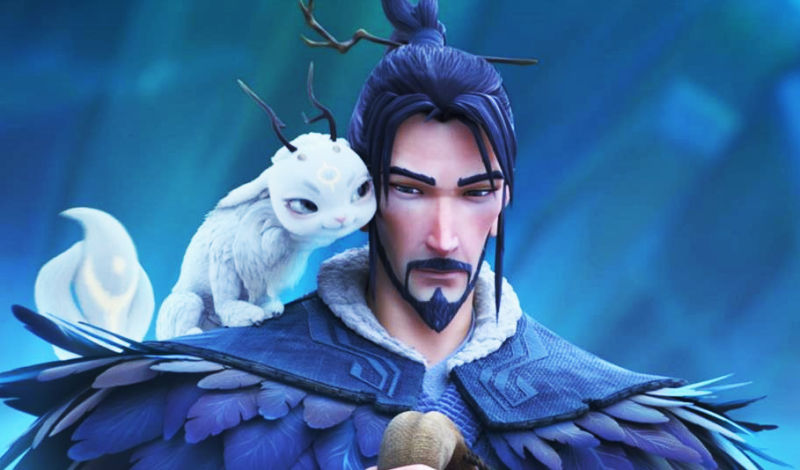
A scene from the animated film (2020) 'Jiang Ziya',
Western Zhou Dynasty 1100-770BCE
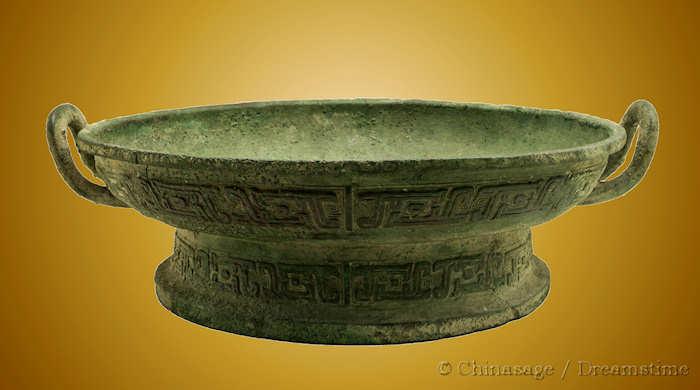
King Wu of Shaanxi, occupying the Wei valley, overthrew the Shang and established the Zhou dynasty moving the center of Chinese culture further east. They were probably outsiders of mixed barbarian (from Gansu province) and Chinese origin. They split the land into 71 fiefdoms for princes and dukes. However it is likely that at this early time each walled town was fairly autonomous with its own local chief.
The Zhou dynasty introduced many innovations that have endured for thousands of years. The first three Zhou rulers are remembered for their exemplary leadership and remain admired for their military prowess, cultivation of the arts and unselfish rule. The early part of Zhou rule was regarded as a ‘Golden Age’ throughout much of Chinese history. The post of Emperor had the title ‘Son of Heaven’ (天子 tiān zǐ) and held the key responsibility of maintaining the rituals needed by the heavenly deities. The concept that the emperor ruled with the ‘Mandate of Heaven’ was important as it permitted rebellion when it was judged by the people that misrule or natural disasters signaled Heaven's displeasure and the loss of the Emperor's right to rule. A successful revolt against Zhou Li Wang ➚ in 841BCE attested to this principle. The Mandate is still considered powerful even into modern times; the devastating Tangshan Earthquake ➚ of 1976 was shortly followed by the death of Chairman Mao. Like the Pope in medieval Europe the emperor was considered the primary link to the gods of heaven and Shangdi in particular. During this early period it was common for human sacrifices to take place after troubling events that were considered signs of heavenly displeasure such as natural disasters. Sacrifices also took place on the death of the emperor; with many high officials buried with him; however this practice slowly fizzled out during the dynasty.
China (Zhongguo - which can be transliterated as the central country) became a meaningful concept at this time. Even though people lived in isolated small communities there was already a feeling of cultural unity with a shared civilization. The world was envisaged as a series of three concentric squares with the Chinese capital at its center, with the level of barbarity increasing the further out you traveled. It is from this viewpoint that the name for the nation ‘Central’ or ‘Middle’ Kingdom originated. Kings of ‘tribes’ to the south accepted a limited degree of fealty to the Zhou rulers. However most of the cultural activity happened in northern China around the Yellow River with its capital at Luoyang. The nation was surrounded by wasteland, deserts, limitless oceans and barbarians launching frequent raids on the settlements. China began to see herself as the cultural and geographical center of the World. This China-centered view has persisted for three thousands years - into the Qing dynasty. In the Zhou dynasty the first walls were built to defend China's northern border; these were later to be joined together in the Great Wall. It is only in the later stages of the Western Zhou that historical records become more consistent and reliable and no longer just tales of the actions of the Emperors. The great capital city of Zhou was at Hao ➚ south-west of modern day Xi'an. After over 300 years, the Western Zhou dynasty was in turn overthrown by the Quanrong ➚ nomadic tribes and disaffected fiefs. The capital city was sacked and destroyed. The son of the defeated emperor set up the new capital further east at Luoyang. This was the start of the Eastern Zhou which is traditionally divided into two periods :Spring and Autumn and Warring States.